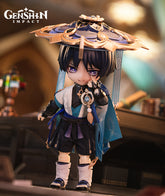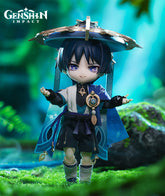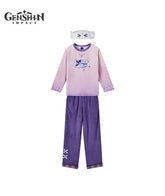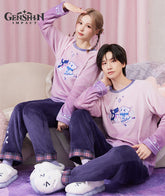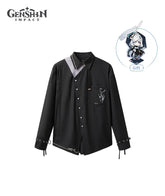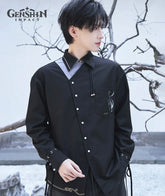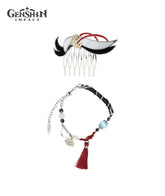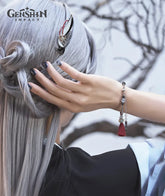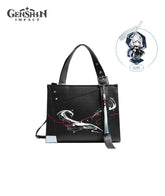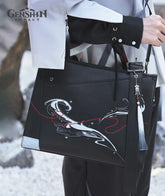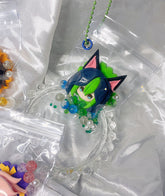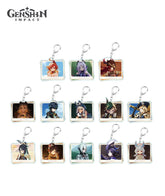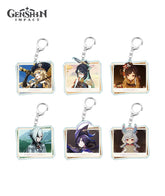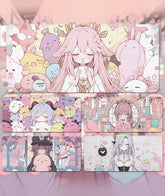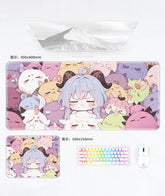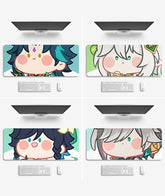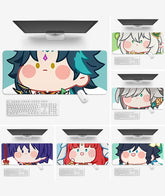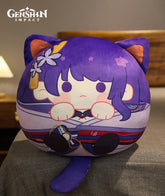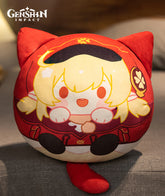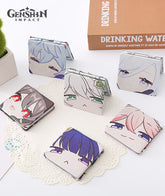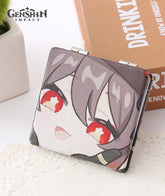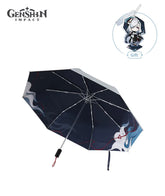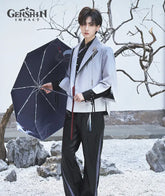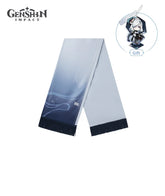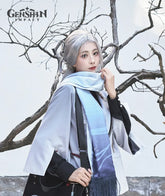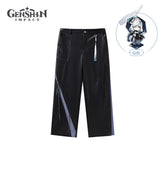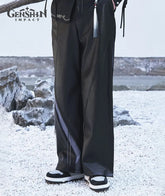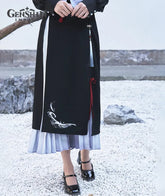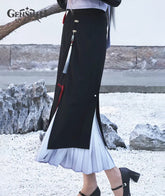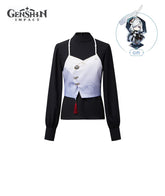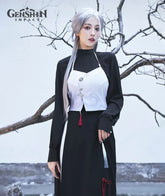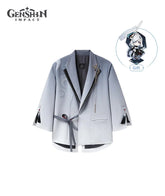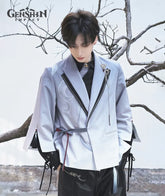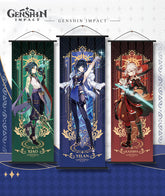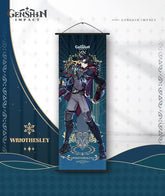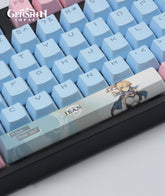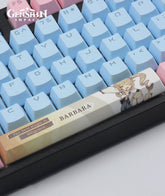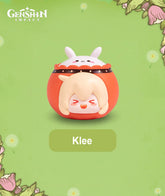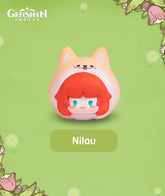Shenhe Genshin: From Cursed to a Adeptus, how did Shenhe change her life?
A character who was born a cursed child, abandoned by his father and changed the course of his life on his own. Today we're going to talk about the controversial character that was introduced in Genshin Impact - Lonesome Transcendence "Shenhe".
1. Meaning of "Shenhe"
"Shenhe" is the phonetic translation of the Chinese word '申 (shen) 鹤 (he)'. The word "鹤" in the name means "Crane", which as a very important animal in Taoism, not only directly leads to the main elements of Shenhe's costume, character and personality design, but also alludes to the deep connection between Shenhe and Taoism.

2. Backstory of Shenhe
Shenhe, originally a young girl from the side line of the Liyue exorcism family, for some reason both her parents died when she was young. She was adopted by the Cloud Retainer and lived with adeptus in a human body. At this point in time, Shenhe was almost the exact opposite of Ganyu, Shenhe had shown amazing will and cultivation talent from a young age. Her long years of cultivation, coupled with her habits of eating immortal grass and drinking mountain dew, made her more and more distant from the life of human, and she was even regarded as a mysterious "White-haired Adeptus".

The most distinctive feature of Shenhe is the dramatic tension created by the contradiction between the two elements of "Adepti" and "Humanity". The design is clearly inspired by the Chinese Taoist culture, supplemented by some elements of Wuxia or even "witch".
3. Appearance Design of Shenhe
Let's start with the design of Shenhe, if I were to describe the design in three words, I would say "Ink", "Tai Chi" and "Crane". The character, when you look at it, is based on the black and white of ink, with the traditional Chinese colors of green, blue and red as accents, which is a kind of color scheme that will make Chinese people more friendly at first glance.
The gradient of black and white gray and the unrestrained cloud pattern create the image of misty and dusty smoke and clouds, while the combination of black and white, including the headpiece, creates the image of mutual growth and tolerance similar to the Tai Chi diagram.

It is interesting to note that Shenhe's design clearly incorporates the "crane"" element, which may not be obvious from the front, but is immediately apparent when you turn to the back of the figure. The hand and the ribbon on the back are clearly modeled after crane feathers, so I personally think that the large black gradient on the front may have been inspired by cranes as well.
Coincidentally, there is indeed a crane with a color scheme very similar to Shenhe. That is, China's first-class protected animal "White-naped Crane", so look at it is not quite similar? The White-naped Crane is often compared to the Red-crowned Crane. As an authentic Chinese crane, the Red-crowned Crane is the "god of the wetland". Black and white feathers with red head part, in Chinese history is recognized as a first-class bird of literature, the Ming and Qing dynasties to the Dan Ding Crane given a loyal and pure, noble cultural connotations, it is listed as second only to the royal use of the dragon and phoenix as an important symbol, and therefore people also call the crane as a "bird of first class".

Symbolizing happiness, good fortune, longevity and fidelity, the red-crowned crane has appeared repeatedly in Chinese literature and art. In ancient Chinese literature, it was once said that "the crane lives for a thousand years". Emperor Jingdi of the Han Dynasty also pointed out that the crane was a "white bird with a vermilion crown". Cranes are also closely associated with Chinese Taoism, as the place where the founder of Taoism, Zhang Daoling, studied Taoism is rumored to be "Crane Mountain/Heming Mountain". Taoist writings also claim that Zhang Daoling could ride a crane to and fro, so it can be said that the imagery of the crane has been closely linked to China's Taoism and immortal/adepti culture from the very beginning.
Shenhe appearance of another very interesting element is the red rope, red rope this element in Chinese culture should be the most famous is the red rope holding up countless marriages of the Yue Lao story.

In Taoism, according to the eight trigrams class image, dry trigrams for the vermilion, belongs to the color of pure yang, have the function of warding off evil spirits, red rope and mahogany is the perfect combination, the effect is doubled. At the same time, red rope can also lock the soul to drive away evil legends, children wear the peace button is often tied with a red rope. There is a peace of mind, the effect of the soul.

Lastly, red ropes can also fill in the gaps in fate. In Chinese Ming Dynasty writings, it was mentioned that people with a "solitary star" in their fate can fill in the gaps in their destiny by wearing red ropes, etc. Shenhe herself is a "solitary star", so using red ropes to fix her fate is naturally the most appropriate way to do so.
Next, let's talk about the pattern on Shenhe's body, and this so-called Lonicera pattern is the detail that has caused a lot of controversy among players. First of all, we need to know what the "Lonicera" pattern is. According to the description in the ancient Chinese book about the pattern, "Lonicera" is also known as "Honeysuckle". Lonicera" is usually presented in the form of an embracing vine or branch as a skeleton, extending up, down, left and right, with the stems intertwined with each other, and the flowers and leaves continuous with a distinct sense of rhythm. It has been endowed with auspicious symbols of good fortune, longevity and longevity, and is mostly used as Buddhist decorations and later developed into scrolling grass patterns and twining branch patterns.

Comparatively speaking, although the patterns on Shenhe's body have the similar basic shape of grass blades such as the Lonicera pattern and the Curly Grass pattern, they do not have the kind of rhythmic, well-organized structure of the Lonicera pattern. Instead, it is more like the flowing and irregular characteristics of the scrolling grass patterns.
Dunhuang's Lonicera pattern itself received some of the Western pattern and the influence of the national pattern, its use prevailed in a large number of absorption of foreign patterns of the North and South Dynasties, and later gradually evolved into a unique Chinese characteristics of the grass pattern, although the style is constantly changing, but the structure of the basic is still clear.

So I personally think that the design of Shenhe's tattoos probably references classic grass and leaf variations such as the Lonicera pattern, which is more aesthetically pleasing than symbolic and doesn't have any clear purpose in it. Or maybe the biggest purpose is aesthetics, with a little bit of auspicious symbolism.
4. Shenhe's Story
Enough about appearance, let's get to the most important part of one of the most important characters, Shenhe's character story and kernel.Shenhe reminds you at the very beginning of your acquaintance "I was born fated to bear the curse of calamity, so I am prone to bring harm to the people around me." And that is Shenhe's destiny.

In the game, according to an adepti's fortune-telling, Shenhe's fate was both "solitary star" and "disastrous evil", and she was also plagued by intense homicidal urges, as well as being a person of supremely ominous destiny, doomed to harm both herself and others. destiny, doomed to harm both herself and others. After awakening, she was also plagued by intense homicidal urges, and was also a person of supremely ominous destiny, doomed to harm both herself and others. Shenhe's awakening was so dangerous that she was able to fight "God" as a child, so adepti bound her soul using red ropes, which made Shenhe's character cold and aloof.

Another obvious core element of Shenhe is the Taoist magic symbol culture; Liyue's exorcist family is based on Chinese Taoist priests, typically the Chongyun, so it's only natural that Shenhe, her sister, would have a strong Taoist influence as well.

As early as during the time of the Yellow Emperor, there was a custom of establishing altars, seeking gods, and granting charms and incantations. According to the Rites of Zhou, bamboo or wooden tablets with seal scripts were used to enter and exit gateways, which is the same as the later Taoist practice of using Taoist magic symbols to communicate with ghosts and gods, and the Taoist magic symbols is a derivative of the charm.
Later, ancient texts recorded that charm became popular in the Han Dynasty and was used by Taoist magic symbol for spells. In the early days of Taoism, charm were used to preach and create religions, and to cure people's illnesses. Since then, charm have become the main form of Taoist magic, and have been widely accepted by society for nearly 2,000 years.

Let's talk about Shenhe's use of traditional Chinese "Xian/Adepti" culture. Anyone who has explored the Liyue region can clearly see that one side of Liyue is smoky, mundane, innovative, and popular, such as Liyue Harbor, while the other side, represented by Jueyun Karst, is dusty, ethereal, ancient, and traditional to represent "Xian/Adepti". tradition to represent the word "Xian/Adepti". Together, these two sides make up the whole look of Liyue, and one cannot exist without the other.
The "Xian/Adepti" culture of Chinese Taoism is an inexhaustible creative ground for this cultural atmosphere. As a matter of fact, China's belief in immortals and fairies is unique in the world. Essentially, the idea of immortals is a product of people's inability to control and properly recognize the power that lies outside of them, and thus to give that power a mystical and humanity character. By combining their own nature with supernatural, superhuman forces and thus endowing these forces with certain human attributes, people are in fact placing their aspirations on the immortals. So we can understand that the immortals are the masters of man and at the same time the role models of mankind. What the immortals have is what man seeks to achieve.

And the difference between Eastern and Western religions lies in the fact that Western religions tend to emphasize the influence of God on human beings and do not focus on the autonomy and agency of human beings themselves, thus keeping them under the influence of God. In Western religions, everything that man desires can only be obtained by relying on the gifts of the gods.
However, the Chinese culture of immortals is not a creation of Taoism, but is linked to the state of being of people living in ancient times, originating in their quest for "infinity" in time and space. In this culture, not only could people use the power of the immortals to achieve their goals, but it was also believed that human beings, with the help of the immortals and with their own efforts, could also acquire immortal-like abilities, i.e., become immortals. This also leads to the fact that, in Taoism, it is considered a normal thing that human beings can become immortals/ Xian. This is also closely related to the Taoist view of the universe and the concept of "the unity of heaven and man" that we mentioned earlier.
Of course, Genshin Impact is an empty world, and Liyue's concept of immortality needs to be adapted under The Seven's worldview, so it doesn't go as deep into the core as the above. However, the appearance of Shenhe does bring out the concept of "immortal cultivation", and the central conflict in his character design, "different paths for human beings and immortals", is a very classic part of Chinese immortal culture.

Although "immortals" can be cultivated, there are different paths for humans and immortals, and choosing an "immortal" requires breaking away from one's attachment. Choosing to be an "immortal" requires severing one's obsession with the world, and this is where a very heartbreaking part of Shenhe's character's story comes into play. The red rope locks up the "disastrous evil" in Shenhe's personality and at the same time locks up part of her normal feelings. But how can her dissatisfaction in her heart and her attachment to the world be swept away so easily?

"Once upon a time, Shenhe had a full head of black hair
...
Cloud Retainer make this comb of white jade from a sacred stone and giving it to her.
The adeptus said that if she ever wished to sever her ties with the mortal world and enter adeptal tutelage, she should brush her hair thrice with this comb, and it would be counted as a rite of apprenticeship.
Shenhe did exactly as the adeptus said without any hesitation. And something strange happened then - for as the jade comb brushed through Shenhe's hair once, a layer of her black locks turned a frosty silver from root to tip.
On the second brush, but half her hair remained dark.
When the process was complete, only a flowing curtain of snow remained.
..."
Shenhe, whether in the introduction or in words, said that she had never regretted, but she really did not regret? If she didn't regret it, how could she sneak down the mountain; if she didn't regret it, how could she grow gray hair; if she didn't regret it, how could there still be a ripple in her heart? All of this shows that her obsession still exists. She has never entered the mortal world, how can she observe heaven and earth, understand the cause and effect and thus understand "Out of the mortal world"?

The age of the immortals is over, and in the new Liyue, although fate is predetermined by destiny, fortune is written by everyone, and the story of Shenhe and traveler is far from being over...
This is all about Shenhe, I believe that after analyzing the character design, you will have a new and deeper understanding of Shenhe's story. This is only a small part of the story of Genshin, and we are looking forward to more characters related to traditional culture to travel with travelers, so let's stay tuned!











